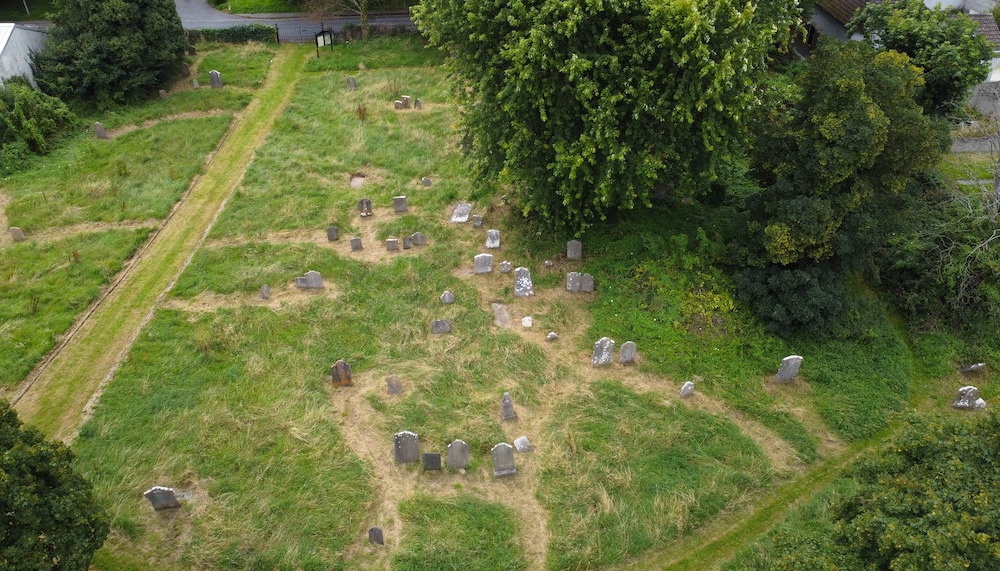With headstones dating from 1720 to 1919, St. Stephen’s Cemetery is unusual in that it was open to all faiths. Due to contamination of the water table it eventually closed and has since slowly returned to nature.


We return to St Stephens Cemetery this Spring with a management plan for the future. Having consulted with the Heritage Council, the remains of the church will return to nature and provide a wonderful habitat for mammals, insects and birds. We reviewed the sleepers used to define the main path and have decided to leave them in situ.
Small paths will reach into the cemetery to invite the public to explore this space. Referencing our past work with Abert Nolan we have installed Bat Roosts on site and continue our plant surveys which we record with the Biodiversity Data centre. Following on from recent storms a number of trees lost limbs and upon inspection were shown to be diseased. Having been removed we are in discussion about replacements. In the meantime the bark has been used to add additional material to our compost bins and the wood itself has been dispersed around our sites to add additional habits.

Much of our work this year has involved raising awareness of public spaces. Some of these forgotten spaces have become littered and attracted anti-social behaviour. By raising the public's awareness of them, we notice that they have become more utilised in positive ways as they are reclaimed. St Stephen's Cemetery is a perfect case in point.
Having taken over care of the graveyard last year, we are recording each headstone, mapping them on our website and continuing to encourage biodiversity on the site. There are about 120 headstones in the graveyard, some in better condition than others. We have also uncovered some headstones that had fallen.
This public space provides an area of wilderness within the town. It becomes part of an internal pollination corridor linking habitats for insects and birds.. Close to Toberhenna Well, St Stephens Cemetery connects this line of our Pollination Corridor with the grounds of the hospital which sits on a huge site, much of it green field. Going forward we will continue to inform the public about the benefits of public green spaces such as this and the benefit they provide to our town and its inhabitants.
May 2022
North Tipperary Development Company provided funding for 20 biodiversity workshops for Tidy towns/Community groups and schools in Tipperary. We were very fortunate to have Albert Nolan to come and visit with us. As part of his workshop, Albert conducted a biodiversity survey. His final report provided us with biodiversity recommendations for this site going forward.
St Stephens Graveyard. We started our workshop in the hallowed ground of St Stephens’s graveyard. There was also a farm on the site in 1700 and the readable and known headstones date mainly from 1720 -1919 but it was probably in use for many years before then. The site contains the remains of St Stephens’s church and roughly 120 remaining headstones. Bordering the graveyard there was a long trench running from the Mental hospital to the morgue where deceased people made their final journey. One of the people on the walk remembers that it did not have a completely enclosed roof and was still in use in the 1950s.
The old stone wall bordering the street is an interesting habitat for wildlife. We recorded two important pollinator friendly plants.
Ivy leaved toadflax. This has long trailing stems that are full of pollen and nectar flowers. Only bumblebees with long tongues can feed on the nectar.
Ivy. This native climber is one of the best native climbers for biodiversity. It provides for birds and insects, nesting and hibernation spots and the larva of moths eat the leaves of ivy. These larva are eaten by birds and the adult moths by bats.
New species of bee. A new species of bee has been discovered on ivy in Kilkenny. Colletes hederae feeds on the flowers of ivy and is probably underecorded. When the ivy flowers in late summer/ early autumn it is worth keeping a watch out for it.
Hartstongue fern has long green fronds and grows in damp and shaded habitats. The leaves were made into a paste that was applied to help heal cuts and burns.
Biodiversity recommendation. Walls are often the neglected habitats and a survey could be carried out to record the different plants found on walls in Clonmel and record any uses associated with them.
This project came about as we saw a need for a space where the gardeners among us could potter to their hearts content. We applied for the care of two cemeteries and were granted one, St Stephens. Once we could safely gather outside, we began to survey the grounds. This survey, which will take some time, will include flowers, grasses, lichen, insects, birds and the graves themselves. Once we have completed the survey, we will map the area on our web site and draw up a plan for the care of this very important part of our wildlife corridor around town. We also plan to erect an old-fashioned Church yard notice board which we can use to inform the public about the graveyard, its history and its biodiversity.